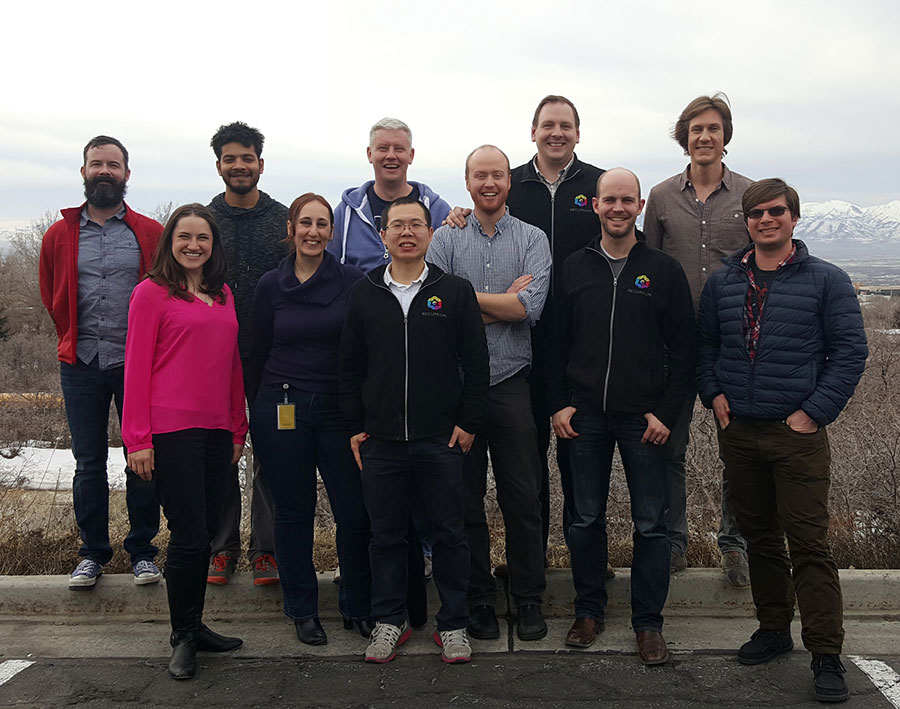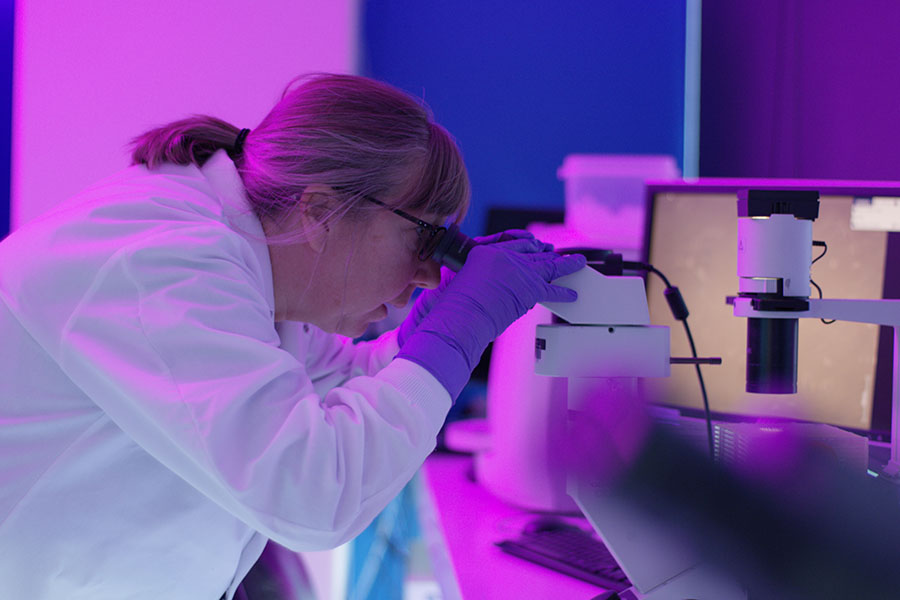NCATS’ Small Business Funding Helps Launch New Platform for Rare Diseases Drug Discovery
In early 2013, Christopher Gibson, an M.D./Ph.D. student at the University of Utah, was exploring potential treatments for cerebral cavernous malformation (CCM), a rare disorder in which misshapen, weakened vessels leak blood into the brain and cause strokes. He had hoped his Ph.D. research would complement his planned future work as a cardiothoracic surgeon treating patients with related conditions. Science intervened: While developing an approach to screen existing drugs for their potential to treat CCM, Gibson saw a way to expand that method into an enterprise to discover hundreds of treatments for thousands of diseases. Deferring his goal of becoming a physician, and with support from NCATS’ Small Business Innovation Research (SBIR) and Small Business Technology Transfer (STTR) programs, Gibson founded a rapidly growing drug discovery company that has, in its first year, attracted more than $3.5 million in private investments.
The SBIR and STTR programs are among the tools in NCATS’ arsenal to catalyze innovation in translational science. Often, academic scientists like Gibson make important discoveries in the laboratory but lack the resources and know-how to carry those ideas into the realm of commercialization, where new interventions can be developed and delivered to patients. The NCATS SBIR and STTR programs bridge this translational gap by providing grants, contracts and technical assistance to small businesses and research organizations focused on advancing translational research and technologies that will improve disease prevention, detection and treatment.
An Idea Is Born
Gibson’s idea was born the day a computer beat biologists at their own game. He and his colleagues were screening for potential CCM drugs using human endothelial cells, which make up the inner walls of blood vessels. The researchers genetically engineered the cells to display CCM-like defects, which included abnormal levels of proteins that normally keep vessels intact. After screening more than 2,000 drugs, the team had a pair of highly trained cell biologists compete against an automated computer program — developed by scientists at the Broad Institute — to select the drugs that most effectively reversed the CCM cells’ defects.

Recursion Pharmaceuticals co-founder and CEO Chris Gibson, Ph.D. (back row, second from right), and his team have developed more than 200 rare disease models on which to test potential drug therapies. (Recursion Pharmaceuticals Photo).
Using microscopic imaging to visualize changes in these cells, the biologists and the computer each selected 39 drugs that appeared to normalize the cells. Remarkably, there was no overlap between the biologists’ and computer’s sets of chosen compounds. To confirm the findings, the researchers screened both sets in another batch of CCM cells, this time measuring the agents’ abilities to normalize dysfunctional cell behavior. One compound from the biologists’ set reversed the defect; to the scientists’ surprise, seven of the computer’s compounds did so.
“That moment convinced me that the computer was seeing what humans can’t. I realized that our high-throughput screening approach, coupled with automated computer analysis, could enable us to much more quickly and efficiently discover potential treatments, not just for CCM but for any number of other rare genetic diseases,” Gibson said. “And screening with existing drugs — repurposing — means that potential therapies can reach patients much sooner than starting from scratch.”
Seeing an opportunity to expand and commercialize this platform, in summer 2013, Gibson enrolled in Stanford Ignite, an entrepreneurship training program through the Stanford University Graduate School of Business. He worked with classmates to further develop his idea, ultimately pitching it to a panel of investors and industry experts.
During the program, Gibson realized that he could take his platform much further than he had first envisioned. “Our initial idea was to start a company and repeat our CCM approach for several other diseases,” Gibson explained. “But the brainstorming at the Stanford Ignite program made us think bigger. We realized, ‘Why focus on one disease at a time? Why not use automation and robotics to carry out high-throughput drug repurposing screens for lots of rare diseases in parallel?’”
From the Ground Up
In November 2013, Gibson and his partners founded Recursion Pharmaceuticals. Gibson received his Ph.D. the following month, and in spring 2014, he applied for NCATS SBIR Phase 2 funding, a $1 million award granted to applicants who already have established the technical merit and feasibility of a project.
Although he wouldn’t find out until many months later that he had received the award, Gibson did know early on that his application had received a very high score. That score — and, later, the SBIR award — helped Recursion attract an additional $3.5 million in private investments.
“The investors specifically said that our SBIR score was instrumental in validating the scientific feasibility of our endeavor,” Gibson said. The SBIR award also garnered attention from major pharmaceutical companies, and negotiations are underway with several large firms. “The SBIR award helped legitimize our project in the eyes of both investors and the pharmaceutical industry and thus was instrumental in getting the company off the ground.”
The SBIR award and private investments quickly enabled Recursion to establish a core group of employees and a few initial rare disease models. The company has continued to grow rapidly.
“Recursion represents a truly pioneering approach, and I’m excited to watch how the company’s stellar team fosters its innovative platform to advance medical science and, hopefully, promising therapies for patients,” said Craig Wegner, Ph.D., head of the Boston Emerging Innovations Unit, Scientific Partnering & Alliances, within AstraZeneca’s Innovative Medicines and Early Development Biotech Unit.
Looking into the Future
Today Recursion has 10 full-time employees and is actively recruiting for at least six more full-time positions. In addition to CCM, the team has developed more than 200 rare disease models on which to test potential therapies and is currently working to validate 12 promising repurposed drug candidates for several rare diseases.
“The large number of currently untreatable rare diseases and the fact that each one can affect multiple organs make the traditional ‘one disease at a time/one organ at a time’ translational model untenable,” said NCATS Director Christopher P. Austin, M.D. “Recursion’s approach to transforming drug discovery for rare diseases is a great potential way to tackle this problem.”
But Gibson and Recursion are just getting started. “Our goal over the next 10 years is to help bring 100 or more new treatments to patients by generating lead therapeutic candidates through the Recursion platform,” Gibson said.
Although the team began with rare diseases, the platform can be adapted to study any number of common diseases and conditions. Already, the Recursion scientists have begun pilot studies to use their system to screen for potential therapies for viral infections, aging, inflammation and cancer.
“The platform can be used to test the effects of thousands of drugs on any biological process of interest,” Gibson said. “It not only can help us discover new therapies but also learn more about basic biology as a whole. Any scientist with a good idea should consider the SBIR/STTR program. It has been transformational for us.”
Posted March 2016
February 2019 Update: A Promising Therapy Enters Clinical Trials
Recursion has now entered its first clinical trial, with a potential treatment for familial CCM. Through this Phase I study, researchers will evaluate the safety of REC-994, one of the first drugs identified through the machine learning approach that led to Recursion’s current drug discovery platform.

Pam Jacobson, director of Recursion’s High-Throughput Screening Cell Culture Core, examines cells being prepared for the drug discovery platform. (Recursion Pharmaceuticals Photo)
Using artificial intelligence to learn and improve over time, Recursion’s platform also has identified a potential drug to treat neurofibromatosis type 2, a rare tumor disorder. Recursion recently licensed the rights to develop the drug, which the Recursion team hopes to move quickly toward clinical trials, based on some initial clinical data already available.
Since the NCATS SBIR Phase 2 award in 2014, which enabled Recursion to hire a core group of employees and attract its first private investments, the company has expanded to more than 120 employees and raised more than $80 million. In addition, from the first few rare disease models made possible by the NCATS funding and other investments, the company has expanded its capabilities to discover therapeutic candidates for several hundred rare and common indications. Recursion is using these models in its own drug discovery programs and in several partnerships with large pharmaceutical companies, including a partnership with Takeda to identify potential new drugs for rare diseases. In less than 18 months, Takeda has exercised an option to continue development of potential drugs for two different rare diseases.

The Recursion team at the opening of the company’s downtown Salt Lake City headquarters in fall 2018. (Recursion Pharmaceuticals Photo)
“We are very pleased with the momentum of our progress since receiving our SBIR grants from NCATS,” said Ron Alfa, M.D., Ph.D., senior vice president at Recursion. “Our ultimate goal is to reimagine the drug discovery process to find new medicines in a fraction of the time and cost of pharmaceutical development today.”
Posted February 2019
February 2022 Update: IPO Signals Continued Success for Drug Development
In April 2021, Recursion reached another major milestone by raising $436 million after its initial public offering (IPO) on the Nasdaq Stock Market. Since receiving an NCATS SBIR Direct to Phase 2 award in 2014, the biotechnology company has doubled the size of its venture rounds — from $60 million in Series B funding in 2017 to $121 million in financing in 2019 to a $239 million round in 2020.
The company is using these investments to advance its drug development pipeline. Recursion’s pipeline includes four drugs currently going through the U.S. Food and Drug Administration approval process to treat several rare diseases, as well as additional treatments in earlier stages of development. Recursion was able to leverage its early SBIR funding from NCATS to secure investments — including a strategic collaboration with Bayer — and to reach important clinical and corporate milestones. In all, Recursion has 37 programs under its roof that focus on areas of significant unmet need. NCATS, through its SBIR program, recognizes the importance of early seed grant funding to help support initial stages of research that can accelerate new approaches for addressing rare and common diseases.
“We’ve always made bold bets in pursuit of our mission: Decode biology to radically improve lives. Today is no different,” said Chris Gibson, co-founder and CEO of Recursion.
Posted February 2022


